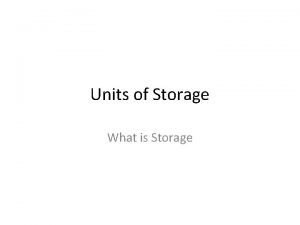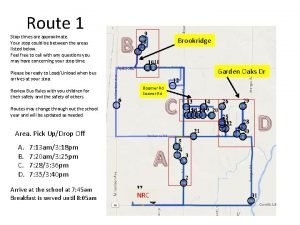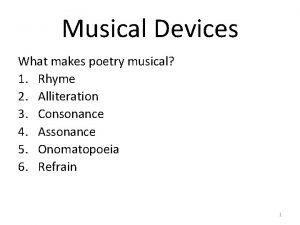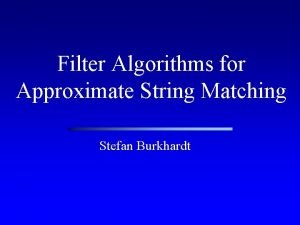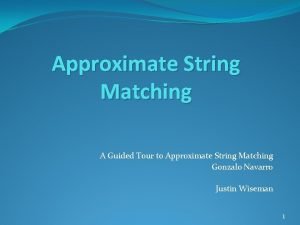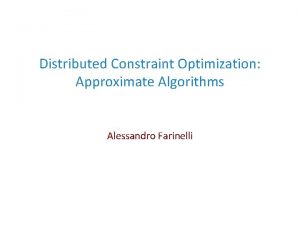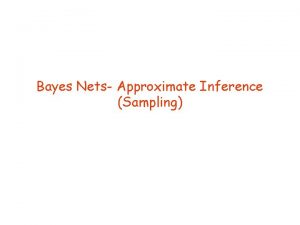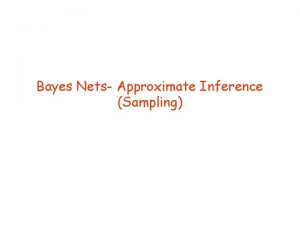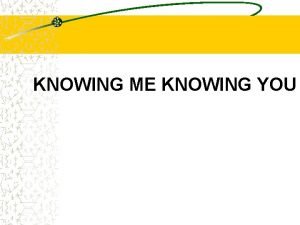How to Approximate a Set Without Knowing Its



![ASM in a picture S ⊆ [100]×[100] |S|=188 |A(S)|=5213 |A(S)|=2699 |A(S)|=1580 |A(S)|=918 ASM in a picture S ⊆ [100]×[100] |S|=188 |A(S)|=5213 |A(S)|=2699 |A(S)|=1580 |A(S)|=918](https://slidetodoc.com/presentation_image/a6dffc68e2a2558301c09f2603e70b33/image-4.jpg)

![Lower Bounds for Static Case: • [CFGMW 78] Lower Bounds for Static Case: • [CFGMW 78]](https://slidetodoc.com/presentation_image/a6dffc68e2a2558301c09f2603e70b33/image-6.jpg)















- Slides: 21

How to Approximate a Set Without Knowing It’s Size In Advance? Rasmus Pagh IT University of Copenhagen Gil Segev Stanford Udi Wieder Microsoft Research

Set Membership •

Approximate Set Membership • |S|= n
![ASM in a picture S 100100 S188 AS5213 AS2699 AS1580 AS918 ASM in a picture S ⊆ [100]×[100] |S|=188 |A(S)|=5213 |A(S)|=2699 |A(S)|=1580 |A(S)|=918](https://slidetodoc.com/presentation_image/a6dffc68e2a2558301c09f2603e70b33/image-4.jpg)
ASM in a picture S ⊆ [100]×[100] |S|=188 |A(S)|=5213 |A(S)|=2699 |A(S)|=1580 |A(S)|=918

Applications • Many…. Very common in practice • Data Bases, Networking and more… • Serves as a filter for accessing slow/bandwidth bounded data Request Filter: Approximation of the Cache External Web Proxy Cache • Requests arrive first at the filter which determines which requests reside in the proxy’s cache and which should be fetched from the network. • The cost of a false positive is a cache miss.
![Lower Bounds for Static Case CFGMW 78 Lower Bounds for Static Case: • [CFGMW 78]](https://slidetodoc.com/presentation_image/a6dffc68e2a2558301c09f2603e70b33/image-6.jpg)
Lower Bounds for Static Case: • [CFGMW 78]

Upper Bounds – Bloom Filters • 1 1 X 1 1

Dictionary Based Upper Bounds •

Separation of Static and Dynamic •

But in practice…. • The size of the set is not known in advance! • Leads to over-provisioning of space up front • Waste of space as long as the set is small • Typically the data structure lies in prime real estate, the whole idea is saving space. • Problem raised and handled in ‘practical’ papers • Typically in a naïve way from a ‘theoretical’ point of view

Main Results (approximate) • Super linear bound!

Lower Bound •

Lower Bound – proof sketch • . . .

Lower Bound: the encoding •

Upper Bound – Construction 1 •

Getting Constant Query Time •

Getting Constant Query Time •

Analysis •

Extensions and standard tricks • Extra space required when rebuilding the new dictionary. Both dictionaries need to be stored until the rebuild is complete. • This can be mitigated by bucketing items into many smaller dictionaries, rebuilding the smaller dictionaries one at a time. • De-amortization of Insert, • Each time an item is inserting, perform O(1) operations on the next dictionary. • Not compatible with bucketing technique, requires a small increase in space.

Supporting Deletions • Necessary assumption: Only items that are in the set are ever deleted. • The removal of a ‘false positive’ item may introduce false negatives • The assumption makes sense in many applications when data structure filters a cache • Standard approach of storing multi-sets is problematic. • An item generates many signatures, can’t tell which one to remove. • Upon insertions, if fingerprint already appears put it in a secondary structure. Upon removal check secondary structure first. • Requires assumption that each item is inserted only once • Requires some extra book keeping.

Open Problems • Bridge a theory – practice gap • Practitioners seem content with the solution of multiple bloom filters • But then, practitioners seem content with Bloom Filters… • Get the leading constant in front of log n THANK YOU
 Knowing is good knowing everything is better
Knowing is good knowing everything is better Not knowing is worse than knowing
Not knowing is worse than knowing Total set awareness set consideration set
Total set awareness set consideration set Training set validation set test set
Training set validation set test set A program that designed to send you advertisements.
A program that designed to send you advertisements. Justify the title of keeping quiet
Justify the title of keeping quiet Without title poem theme
Without title poem theme The father in the poem without title
The father in the poem without title Crisp set vs fuzzy set
Crisp set vs fuzzy set Bounded set vs centered set
Bounded set vs centered set What is the overlap of data set 1 and data set 2?
What is the overlap of data set 1 and data set 2? Fucntions
Fucntions Correspondence function examples
Correspondence function examples Crisp set vs fuzzy set
Crisp set vs fuzzy set Units of storage in computer
Units of storage in computer Times are approximate
Times are approximate Are tiny elevation or hill like structures
Are tiny elevation or hill like structures What is consonance
What is consonance What does this map represent
What does this map represent Approximate computing
Approximate computing Approximate 645 to the nearest hundred
Approximate 645 to the nearest hundred A guided tour to approximate string matching
A guided tour to approximate string matching














